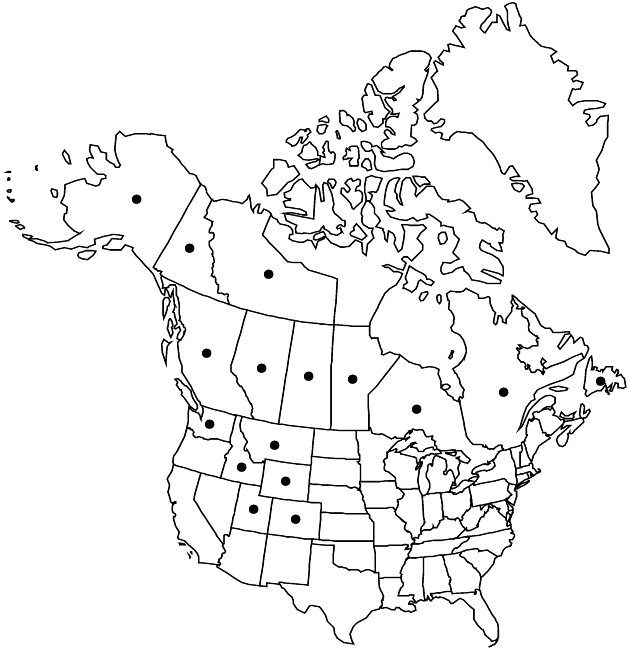Difference between revisions of "Antennaria pulcherrima"
Pittonia 3: 176. 1897.
FNA>Volume Importer |
RevisionBot (talk | contribs) m (Bot: Adding category Revised Since Print) |
||
| (5 intermediate revisions by 3 users not shown) | |||
| Line 8: | Line 8: | ||
}} | }} | ||
|common_names=Showy or handsome pussytoes;antennaire magnifique | |common_names=Showy or handsome pussytoes;antennaire magnifique | ||
| + | |special_status={{Treatment/ID/Special_status | ||
| + | |code=E | ||
| + | |label=Endemic | ||
| + | }} | ||
|basionyms={{Treatment/ID/Basionym | |basionyms={{Treatment/ID/Basionym | ||
|name=Antennaria carpatica var. pulcherrima | |name=Antennaria carpatica var. pulcherrima | ||
|authority=Hooker | |authority=Hooker | ||
| + | |rank=variety | ||
|publication_title=Fl. Bor.-Amer. | |publication_title=Fl. Bor.-Amer. | ||
|publication_place=1: 329. 1834 | |publication_place=1: 329. 1834 | ||
| Line 17: | Line 22: | ||
|name=Antennaria pulcherrima var. angustisquama | |name=Antennaria pulcherrima var. angustisquama | ||
|authority=A. E. Porsild | |authority=A. E. Porsild | ||
| + | |rank=variety | ||
}} {{Treatment/ID/Synonym | }} {{Treatment/ID/Synonym | ||
|name=Antennaria pulcherrima var. sordida | |name=Antennaria pulcherrima var. sordida | ||
|authority=B. Boivin | |authority=B. Boivin | ||
| + | |rank=variety | ||
}} | }} | ||
|hierarchy=Asteraceae;Asteraceae tribe Gnaphalieae;Antennaria;Antennaria pulcherrima | |hierarchy=Asteraceae;Asteraceae tribe Gnaphalieae;Antennaria;Antennaria pulcherrima | ||
| Line 31: | Line 38: | ||
-->{{Treatment/Body | -->{{Treatment/Body | ||
| − | |distribution= | + | |distribution=Alta.;B.C.;Man.;N.W.T.;Nfld. and Labr. (Nfld.);Ont.;Que.;Sask.;Yukon;Alaska;Colo.;Idaho;Mont.;Utah;Wash.;Wyo. |
|discussion=<p>Subspecies 2 (2 in the flora).</p><!-- | |discussion=<p>Subspecies 2 (2 in the flora).</p><!-- | ||
--><p><i>Antennaria pulcherrima</i> is characterized by relatively large basal leaves, rhizomatous growth, and dark-colored phyllaries, each with a relatively large black spot at the base (R. J. Bayer and G. L. Stebbins 1987).</p> | --><p><i>Antennaria pulcherrima</i> is characterized by relatively large basal leaves, rhizomatous growth, and dark-colored phyllaries, each with a relatively large black spot at the base (R. J. Bayer and G. L. Stebbins 1987).</p> | ||
| Line 56: | Line 63: | ||
-->{{#Taxon: | -->{{#Taxon: | ||
name=Antennaria pulcherrima | name=Antennaria pulcherrima | ||
| − | |||
|authority=(Hooker) Greene | |authority=(Hooker) Greene | ||
|rank=species | |rank=species | ||
| Line 63: | Line 69: | ||
|basionyms=Antennaria carpatica var. pulcherrima | |basionyms=Antennaria carpatica var. pulcherrima | ||
|family=Asteraceae | |family=Asteraceae | ||
| − | |distribution= | + | |distribution=Alta.;B.C.;Man.;N.W.T.;Nfld. and Labr. (Nfld.);Ont.;Que.;Sask.;Yukon;Alaska;Colo.;Idaho;Mont.;Utah;Wash.;Wyo. |
|reference=None | |reference=None | ||
|publication title=Pittonia | |publication title=Pittonia | ||
|publication year=1897 | |publication year=1897 | ||
| − | |special status= | + | |special status=Endemic |
| − | |source xml=https:// | + | |source xml=https://bitbucket.org/aafc-mbb/fna-data-curation/src/2e0870ddd59836b60bcf96646a41e87ea5a5943a/coarse_grained_fna_xml/V19-20-21/V19_637.xml |
|tribe=Asteraceae tribe Gnaphalieae | |tribe=Asteraceae tribe Gnaphalieae | ||
|genus=Antennaria | |genus=Antennaria | ||
| Line 74: | Line 80: | ||
}}<!-- | }}<!-- | ||
| − | -->[[Category:Treatment]][[Category:Antennaria]] | + | --> |
| + | |||
| + | [[Category:Treatment]] | ||
| + | [[Category:Antennaria]] | ||
| + | [[Category:Revised Since Print]] | ||
Latest revision as of 18:31, 6 November 2020
Dioecious. Plants (8–)30–65 cm (caudices branching or rhizomes stout). Stolons none. Basal leaves 3–5-nerved, spatulate to oblanceolate or lanceolate, 50–200 × 4–25 mm, tips acute, mucronate, faces gray-pubescent or silvery sericeous. Cauline leaves linear, 8–140 mm, distal flagged or not. Heads 3–30 in corymbiform to paniculiform arrays. Involucres: staminate 5–8 mm; pistillate 7–12 mm. Phyllaries distally black, dark brown, light brown, castaneous, or olivaceous. Corollas: staminate 3–5 mm; pistillate 3–6 mm. Cypselae 1–1.5 mm, glabrous; pappi: staminate 4–6 mm; pistillate (5–)8–10 mm. 2n = 28, 56.
Distribution

Alta., B.C., Man., N.W.T., Nfld. and Labr. (Nfld.), Ont., Que., Sask., Yukon, Alaska, Colo., Idaho, Mont., Utah, Wash., Wyo.
Discussion
Subspecies 2 (2 in the flora).
Antennaria pulcherrima is characterized by relatively large basal leaves, rhizomatous growth, and dark-colored phyllaries, each with a relatively large black spot at the base (R. J. Bayer and G. L. Stebbins 1987).
Selected References
None.
Key
| 1 | Cauline leaves: distal usually flagged; corollas: staminate 3.5–5 mm; pistillate 4–6 mm; wet sites, willow thickets, subalpine or subarctic, Colorado to Alaska, e to Ontario, w Quebec | Antennaria pulcherrima subsp. pulcherrima |
| 1 | Cauline leaves: mostly not flagged (sometimes flagged near heads); corollas: staminate 3–4 mm; pistillate 3–4.3 mm; limestone near sea level, w Newfoundland, Anticosti Island | Antennaria pulcherrima subsp. eucosma |